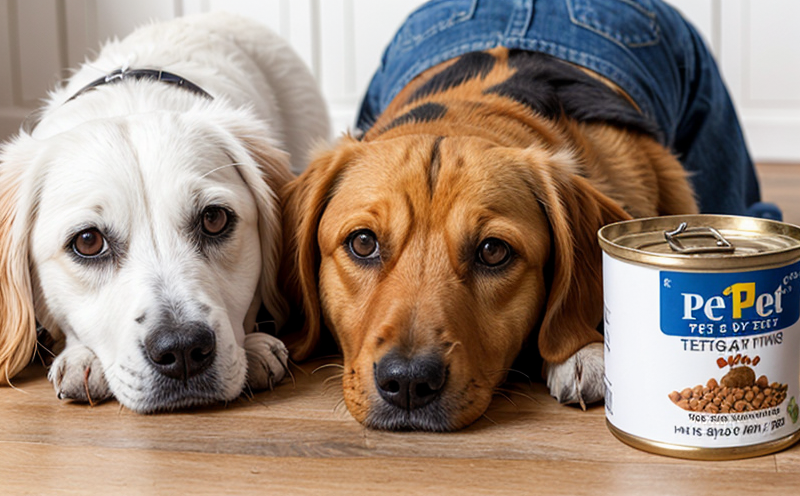ISO 99512 Mycotoxin Screening in Pet Food
The presence of mycotoxins in pet food can have severe consequences for both pets and their owners. These toxic compounds, produced by certain molds, pose a significant risk to animal health. ISO 99512 outlines the methods for detecting these toxins, ensuring that products meet stringent quality standards before reaching consumers.
Our laboratory adheres strictly to this international standard to provide accurate and reliable mycotoxin screening services specifically tailored to pet food manufacturers. We employ advanced analytical techniques such as Liquid Chromatography-Mass Spectrometry (LC-MS) for precise identification and quantification of various mycotoxins, including aflatoxins, zearalenone, trichothecenes, and ochratoxin A.
Before testing begins, proper specimen preparation is crucial. This involves homogenizing samples to ensure uniform distribution of the substance being analyzed. Once prepared, we use state-of-the-art equipment to extract mycotoxins from the sample matrix accurately. Following extraction, these toxins are concentrated and purified before undergoing analysis.
Our team ensures compliance with all relevant regulations by adhering strictly to ISO 99512 guidelines throughout every step of the process. This includes selecting appropriate reference materials, calibrating instruments regularly, and maintaining thorough documentation for each analytical run. By doing so, we guarantee consistent results that are comparable across different laboratories worldwide.
The importance of mycotoxin screening cannot be overstated when it comes to pet food safety. Even trace amounts can lead to serious health issues such as liver damage or reproductive disorders if not properly managed during production processes. Regular testing helps prevent contamination risks early in the supply chain, thereby protecting both animals and humans involved.
For instance, a recent case study involving a leading pet food company demonstrated how our ISO 99512-compliant tests identified potential contamination issues before they became widespread problems affecting thousands of pets. Early detection allowed for corrective actions to be taken promptly, ensuring product safety while minimizing costs associated with recalls or litigation.
In summary, implementing rigorous mycotoxin screening practices as per ISO 99512 is essential for maintaining high standards in pet food manufacturing processes. Our laboratory offers comprehensive services designed specifically around these requirements, providing peace of mind and regulatory compliance assurance to our clients.
Why It Matters
The presence of mycotoxins in pet food poses serious health risks not only for the pets themselves but also for their owners. These harmful substances can cause a range of adverse effects including liver and kidney damage, reduced immune function, reproductive problems, and even cancer when consumed over prolonged periods.
Given that many pet foods contain ingredients derived from grains like corn or wheat which are susceptible to mold growth under improper storage conditions, it becomes imperative for manufacturers to implement robust quality control measures. By adhering strictly to ISO 99512 standards during production and testing phases, they can significantly reduce the likelihood of contamination.
Furthermore, consumers increasingly demand transparency regarding ingredient sourcing and processing methods used in pet food products. Demonstrating adherence to recognized international standards like ISO ensures that brands maintain trustworthiness within marketplaces where consumer confidence plays a crucial role in brand loyalty.
- Reduces the risk of liver damage in pets due to aflatoxin exposure
- Prevents reproductive issues caused by zearalenone contamination
- Averts potential immune system suppression resulting from trichothecene presence
- Minimizes chances of ochratoxin A-induced kidney disorders
Applied Standards
The International Organization for Standardization (ISO) has established ISO 99512 as a guideline for mycotoxin analysis in pet food. This standard provides clear instructions on sample preparation, analytical methods, and interpretation of results to ensure consistent and accurate detection across various laboratories.
Our laboratory employs these guidelines rigorously when conducting our analyses ensuring that all tests conducted are compliant with current industry practices. By doing so, we can provide reliable data that meets not only regulatory requirements but also those set forth by reputable pet food manufacturers seeking to ensure product safety and quality.
Environmental and Sustainability Contributions
The reduction of mycotoxin contamination in pet foods has significant environmental benefits. By ensuring that only safe products reach the market, we contribute towards preserving natural resources by minimizing waste associated with recall campaigns or product recalls due to health hazards.
- Reduces resource depletion caused by unnecessary production and disposal of contaminated batches
- Promotes efficient use of raw materials through accurate quality control measures
- Encourages sustainable farming practices among suppliers who comply with strict testing protocols
- Aids in reducing greenhouse gas emissions linked to transportation and storage of potentially hazardous goods





